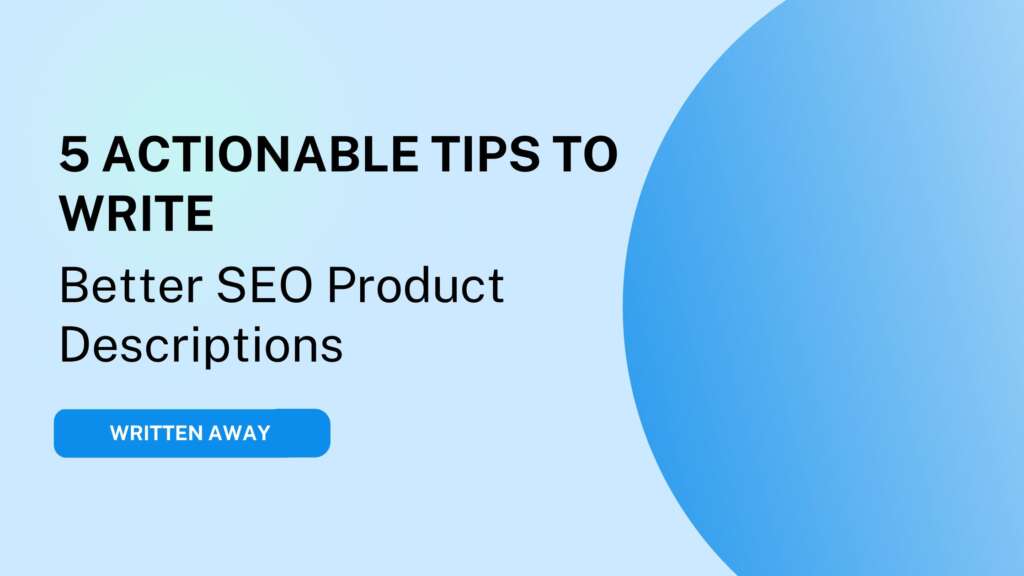
Just because you skip SEO product descriptions, doesn’t mean they’re not important or interesting (yes, most aren’t interesting or useful)
But if done right, they drive traffic to your commercial pages, educate customers, and help them make the right decisions (aka: buying from you).
But you might wonder, ‘It doesn’t matter what I write in the SEO product description as long as it has all the right keywords; after all, no one is reading product pages.’
People read product pages when there’s valuable information about the product they want to buy. If there’s no information, they might go with an alternative option.
Think about it this way: You want to buy a new TV. Would you buy it from a website that has no description of the TVs you want or one that describes different features and benefits and makes the ordering process clear?
In this article, you’ll discover why SEO product pages are important, what mistakes to avoid when creating an SEO product description, and how to write valuable and unique copy for every product on your website.
Let’s go!
Why are SEO product descriptions important?
Well-written product pages give more credibility to your website and increase your organic traffic because you can optimize your content better.
When done right, SEO product descriptions can:
- Target several keywords
- Reach a recommended word count
- Help attract more organic traffic based on general search queries
- Help visitors make decisions about products
- Show visitors how to use products
The problem with writing product descriptions for SEO
Many e-commerce vendors don’t have sufficient descriptions on their product pages (less than the recommended 300 words). Even when they do, the content is cramped into a few sentences, repeating the same information across several pages.
Many of those offer zero value for the customer and can be classified by search engine crawlers as duplicate content and be excluded from search results altogether. And that’s something you definitely want to avoid.
I get it. When you have 1000+ products, writing individual descriptions is overwhelming. But each product is unique, and so should be its description. When you invest time in creating comprehensive and helpful product descriptions, you can reap the benefits of increased page traffic, sales, and customer trust.
Basic rules to follow when writing product pages
Before we talk more about structuring and writing your SEO product page, let’s mention a few things that are the foundation for your product page.
- Make it longer than 300 words: While there’s no official rule, Google prefers longer copies. Three hundred words should be a minimum to present and describe a product. Some product pages might be longer or shorter, depending on how much information you need to cover the topic.
- Don’t duplicate your content: Duplicate pages damage your rankings and confuse readers. If you post identical copies for similar products, Google might not show them on search results or even penalize your website.
- Write for people: Your SEO page descriptions should be easy to read and conversational. Avoid highly technical phrases or descriptions that read like a manual. To make content more scannable, use multiple headers, bullet points, illustrations, and other structuring elements.
- Make it useful: When writers don’t know what to write, they start creating, stuffing text with unnecessary words, or worse yet, becoming poetic. Unless your selling point is creativity, art, or poetry, please don’t make your product pages sound like Shakespeare wrote them. Customers want to know how to use the product, its benefits, and how they can get it, not to sit through an English literature class.
5 Tips on how to plan, structure, and write better SEO product descriptions
1. Plan your keywords
Your product page contains information about the product, but visitors come here to make a purchase. Therefore, your keywords should have commercial intent. Commercial intent indicates that when someone searches for that keyword, they have an intention to buy.
You can identify commercial intent by checking the CPC value or SEO tool results. In many cases, the higher the CPC value is, the more likely a keyword is commercial. However, this might not be the case for all consumer products.
For example, I put a query for ‘Windows laptop.’ SEranking shows that the keyword has a commercial intent, even though the CPC value is low:
On the other hand, long-tail keywords like ‘What is better a MAC or Windows laptop’ are informational and might not be the best target for an SEO product description:
Better yet, make a separate Excel document to group keywords based on the intent and products. This way, you’ll avoid keyword cannibalization and have a clear strategy.
2. Structure your SEO page like a pro
Forget boring product descriptions that are just large blocks of text in the font size 8. Great SEO product descriptions have clear H1, H2, and H3 headings and short paragraphs to make them easier to read.
The scannable structure guides the reader to learn more about your product and makes it easier for them to find relevant details. Clear headings are also great for targeting keywords and showing Google that your content is user-friendly.
3. Write SEO-friendly product descriptions
When it comes to writing a product page, most writers come to face a brick wall. Perhaps you’re selling car parts, and writing 300+ words about each lighting system part seems impossible (I’ve been there). Don’t worry, I got you. Here are some tips to produce more useful content for your readers.
Describe what you’re selling
Once you have your H1, write a few sentences about the product—what it is, why people need it, and what your part in the whole process is. Be relevant and relatable. Use real-life examples and explain even the most difficult features in simple language. You can also mention how visitors can purchase this product and why they should do it in your store.
Describe how your product works
Explain the most important features, how they work, why they are important, and other relevant details about your product. Does your product work for a specific segment?
For example, you can describe features based on different segments like ‘Desktop computers for students,’ ‘Desktop computers for office workers’, or ‘Desktop computers for gamers.’
Targeting these long tail, commercial keywords gives you more space to explore the product and its features tailored to these distinct segments.
Describe the benefits
What are the advantages of the products you sell? Let’s circle back to the laptop example. Perhaps you provide economic options for customers seeking efficiency while on a budget. Or, you might offer advanced models, ideal for gaming and running resource-intensive software. When listing these benefits, consider them from the customer’s perspective
Check what people ask
Once you cover the description of a product, check what people are asking. You can do so on websites like Also Asked and Answer the Public. They are a great source of inspiration when you have no idea what to write. You can also check the ‘People also ask’ rich snippet on Google. Answer the listed questions on your product page. Let’s come back to the desktop computers. Here is what my search got me:
If the questions are too broad or irrelevant to your page, you can select a question, and similar queries will appear, giving you more options.
Describe the next steps
So, what’s next? Now, the visitor knows what you sell and why it’s the best product. But what do they do next? It’s important to clearly indicate how the process works. If you’re selling physical products like computers, you can have a section that describes your purchasing process, delivery options, and policies.
Make it easy so a potential buyer can find all this information without leaving your product page. It doesn’t have to be a copy of your shipping policy, it can sound as simple as: ‘Order online without leaving your home, and receive the (product) on the same day.’
4. Optimize your images
Optimize your product images for the best results. You should write ALT text for each image that appears on the page. Before you upload images, rename files to describe what the image is about.
Instead of “Image34934,” it should be “Apple desktop computer“(yes, I’m still talking about computers) or something similar. This helps search engines to identify the information that’s displayed in the image.
Also, don’t forget to compress larger files to increase page loading speed.
5. Write unique meta titles and descriptions
Meta descriptions and titles deserve a separate article. They’re very important because meta description information is what potential customers see when they search for products. You can imagine that if you’re selling something like desktop computers, there will be many more vendors like you.
Your meta information has to make you stand out. That’s why it’s important to write unique meta descriptions for every product and mention what makes you stand out. Think of it as your unique selling point. Perhaps you do same-day delivery or ship to every country in the world. Mention this information in your meta information.
See how these vendors use their unique selling points:
And avoid descriptions like this, that use the text from the page copy:
Find the right writer to transform your product descriptions
I hope you found valuable tips in this article. As a writer, I know how difficult it is to produce numerous product descriptions, so I hope this makes it easier for you. If you’re looking for a content writer to turn your product descriptions into powerful SEO product pages, send me a message, and let’s talk.


